From ancient times until today
- Nakhchivan since ancient times up to the period of khanates
- The Period of Khanates
- Khans of Nakhchivan
- The Period of Occupation by Russia
- The Araz Turk Republic
- Nakhichivan Autonomous Region
- The Nakhchivan Autonomous Republic
- The Period of Independence
Nakhchivan since ancient times up to the period of khanates
An ancient land of Azerbaijan, Nakhchivan is one of the first human settlements to give birth to life on Earth. Here the people of Azerbaijan created an ancient and rich culture. At the same time, Nakhchivan is one of the ancient centers of world culture. Nakhchivan is closely linked with Ancient Eastern civilizations like the other districts of Azerbaijan, and has left a deep trace on the course of historical development. A rich historical, scientific and cultural heritage of the Azerbaijani people has emerged here.
Scientists explain the origin of the word «Nakhchivan» in different ways. According to Azerbaijani etymology and authoritative historical sources, «Nakhchivan» was developed from the words «Nagshi-jahan», that is, «ornament of the world», or «adornment of the world». Another story widely spread among people says the geographical name «Nakhchivan» is linked with the prophet Noah, or more exactly, with the «global flood» and means «Nuhchuvan» - «the land of Noah’s followers», or «Noah’s land». Indeed, the «Gamigaya» ancient settlement located at 3725 m. above sea-level and a very ancient cemetery named «Nabi Yurdu» («Land of the Prophet») situated in the settlement has been discovered near Nakhchivan. And the Prophet Noah’s tomb is in the city of Nakhchivan. In general, the phrase «Left from the prophet Noah» is very popular among the people of Azerbaijan, as well as the population of Nakhchivan, when referring to ancient monuments and antique items.
The word «Nakhchivan» is also interpreted as «Nakchuana / Nakhchuan», «the land of magical or nice waters», or «country of healing mineral waters».
* * *
Diggings by Azerbaijani archeologists have proven that the first settlements of ancient humans were formed in Nakhchivan as far back as the Stone Age (Paleolithic Age). Abundant archeological materials belonging to the period have been discovered in different parts of the land, particularly in the Gazma Cave (Sharur District). These materials have enriched geographical research of the Paleolithic age in Azerbaijan and the world.During the Neolithic (the New Stone Age) revolution, the emergence of a production economy (8th-6th millennia BC) was an event of vital significance in the history of Nakhchivan as well.
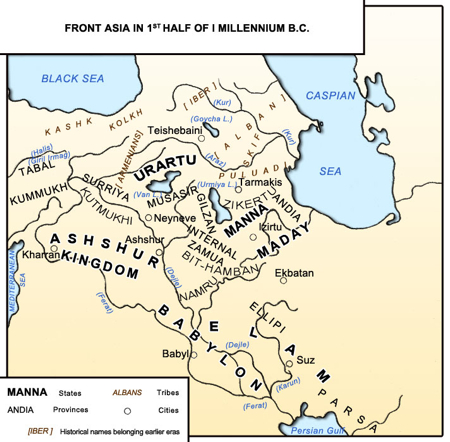 The production economy progressed further in the Eneolithic (copper and stone) Age. The links of Azerbaijan in general, as well as Nakhchivan, with Mesopotamia, the center of global civilization, expanded in this period. The monuments of the 1st Kultepe (Babak region), Ovchulartepe (Sharur district), Damlama (Kangarli district) and others reflect brilliantly the history of these archeological ages. Instruments of labor made from a mixture of copper and silver found in the 1st Kultepe (middle of the VI millennium BC) explain this initial period in which copper was first made in Nakhchivan.
The production economy progressed further in the Eneolithic (copper and stone) Age. The links of Azerbaijan in general, as well as Nakhchivan, with Mesopotamia, the center of global civilization, expanded in this period. The monuments of the 1st Kultepe (Babak region), Ovchulartepe (Sharur district), Damlama (Kangarli district) and others reflect brilliantly the history of these archeological ages. Instruments of labor made from a mixture of copper and silver found in the 1st Kultepe (middle of the VI millennium BC) explain this initial period in which copper was first made in Nakhchivan. Nakhchivan has very rich monuments belonging to the Bronze Age as well (IV-II millennia BC). There are many valuable archeological monuments in this land reminding us of all the stages of this age. The archeological materials found from the world-scale 1st Kultepe, 2nd Kultepe (Babak region), Ovchulartepe, Makhta (Sharur district) and other monuments serve as direct evidence of this. In the Bronze Age, the economic life of Nakhchivan flourished, ethnic processes intensified, and economic links and art progressed. The Gamigaya petroglyphs (Ordubad district, III-I millennia BC) are very valuable examples of the continuance of the Gobustan traditions.
In addition to the Kur-Araz culture (First Bronze Age), which was distinctive for Azerbaijan, unique archeological cultures, such as the culture of painted wares (III-I millennia BC) and the Nakhchivan culture (Last Bronze - First Iron Ages) also emerged in Nakhchivan.
The ancient inhabitants of the Nakhchivan territory, the Azerbaijani tribes and tribal unions that formed here played a significant role in the ethnic and political history of Azerbaijan.
The land of Nakhchivan is one of the earliest urban locations in the world. The main city of the territory, Nakhchivan, is considered one of the ancient cities of the East and the entire world. Over 3500 years old, Nakhchivan city later became one of the economic, political and cultural centers of Azerbaijan. At the same time, Nakhchivan played an essential role in the formation and development of Azerbaijani statehood.
In the first centuries of the 1st millennium BC, Nakhchivan was a part of the Mannan state [IX - late VI centuries ВС]. The Mannan state succeeded in maintaining its independence, fighting against the neighboring states of Assyria and Urartu. The struggle against Urartu is reflected in the Ilandagh cuneiform (Julfa district) from 820-810 BC. Information about this monument was first published in an Italian journal in 1989.
Following the collapse of the Mannan state, Nakhchivan was first annexed to the Medea State [late VII century BC-550 BC], and then to the Ahamani Empire [550 BC - 330 ВС].
After the death of Alexander the Great [336-323 BC], Azerbaijan’s independence was restored. The state of Atropatena was established in the south, and the state of Albania in the north of the country. The territory of Nakhchivan was included in the state of Atropatena.
In antique times and the first centuries AD, the economic and cultural progress of Nakhchivan accelerated. The international links of this Azerbaijani land expanded to cover wider areas. Valuable archeological materials belonging to that period have been found at the Aghbulag (Shahbuz district), Gahab (Babak district), Govurgala, Alban-tepe, Akhura Kultepesi, Pusyan Necropolis (Sharur district) and other monuments. Information about Nakhchivan was cited in books by Roman and Greek authors during this period as well. Joseph Fluffy (I c. BC) and Claude Ptolemy (II c. BC) mentioned Nakhchivan in their writings.
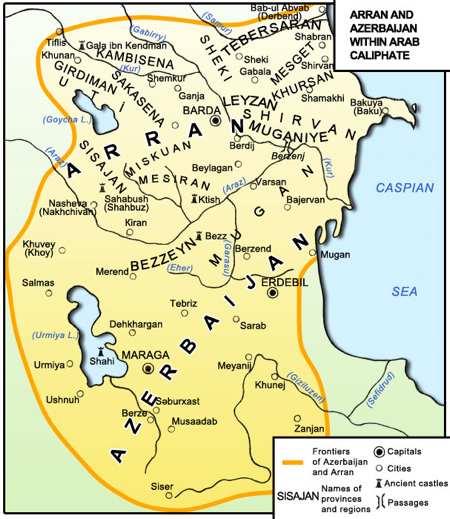 In the III century AD, the Iranian State of Sassani [224-651] began to strengthen. Destructive wars broke out among the Sassani, Roman and Byzantine Empires for regional dominance. This struck hard blows upon Nakhchivan. However, its military-strategic position and location on the trade routes soon delivered a strong push to the development of Nakhchivan. According to some sources, in the Middle Ages there were about 30,000 houses in Nakhchivan and its population numbered 150,000. In certain periods, it was the headquarters of the Sassani viceregents (merzbans). One of the ancient Azerbaijani mints, the Gilan Mint (Ordubad district), was situated in Nakhchivan. Sassani coins were minted here with the word «nakhch». The weakening of the power of the Sassanis and the restoration of Azerbaijani statehood positively affected Nakhchivan. Coins of this period (V-VI c.), a statuette of the Albanian ruler Javanshir (638 - 680/81) (SPb, Hermitage), a statue of a griffon (Julfa district), the Bilav Castle and other extensive archeological materials found in Damirlar, Kharabagilan (Ordubad district), Dalma (Shahbuz district) and other settlements speak about this progress.
In the III century AD, the Iranian State of Sassani [224-651] began to strengthen. Destructive wars broke out among the Sassani, Roman and Byzantine Empires for regional dominance. This struck hard blows upon Nakhchivan. However, its military-strategic position and location on the trade routes soon delivered a strong push to the development of Nakhchivan. According to some sources, in the Middle Ages there were about 30,000 houses in Nakhchivan and its population numbered 150,000. In certain periods, it was the headquarters of the Sassani viceregents (merzbans). One of the ancient Azerbaijani mints, the Gilan Mint (Ordubad district), was situated in Nakhchivan. Sassani coins were minted here with the word «nakhch». The weakening of the power of the Sassanis and the restoration of Azerbaijani statehood positively affected Nakhchivan. Coins of this period (V-VI c.), a statuette of the Albanian ruler Javanshir (638 - 680/81) (SPb, Hermitage), a statue of a griffon (Julfa district), the Bilav Castle and other extensive archeological materials found in Damirlar, Kharabagilan (Ordubad district), Dalma (Shahbuz district) and other settlements speak about this progress. During the period of Arabian invasions (VII-VIII centuries), Nakhchivan, as well as the other lands of Azerbaijan, were annexed to the Arabian Caliphate. When occupying the city of Nakhchivan, the Arabian warlord Habib ibn Maslame signed a special agreement about his obligations with the city population.
The spread of the Islamic religion and the expansion of mutual links with the countries within the Arabian Caliphate positively affected the development of Azerbaijan, including Nakhchivan. Nevertheless, refusing to accept alien bondage, the people of Azerbaijan stood up in a struggle for freedom against Arabian servitude. One of the main centers of the war for freedom, led by Babak [816-837], was Nakhchivan. Arabian sources started to provide more information about Azerbaijan in general, as well as Nakhchivan. Al-Belazuri, Ibn Khordadbeh, al-Mugaddasi, al-Istekhri, al-Biruni, Yagut Hamavi and other distinguished historians and geographers would describe Nakhchivan comprehensively.
One of the convincing facts of Nakhchivan’s prominence in the entire Islamic world is that the ancient As-habi-Kahf («Cave Holders») monument located here and belonging to the Tanrichilig sect is mentioned in ayas (verses) 9-26 of the 18th surah of the Guran (Quran, Koran) - the Al-Kahf («The Cave») surah. These ayas (verses) speak about those youth, who parted from those believing in others than Allah and took shelter in the cave, their sleep lasting for more than 300 years and the events happening to them after they woke up. As-habi-Kahf increased Nakhchivan’s fame even more, and became a famous place of Moslem pilgrimage. The Alinjeriver cloister for dervishes (Julfa district) also belongs to this period, existing since the VIII century.
 The war for freedom led by Babak stimulated the weakening of the Arabian Caliphate. Independent states ruled by the dynasties of the Shirvan-shahs, the Sajis, the Salaris, the Rawadis, the Shaddadis and the rulers of Shaki appeared in the territory of Azerbaijan. Nakhchivan was a part of two Azerbaijani states, firstly the one controlled by the Sajis, and then the Salaris. Some sources report that approximately from the 80’s of the X century till the mid XI century, an emirate called the Nakhchivankingdom was created on the territory of Nakhchivan, and was ruled by the Abu-dulefis dynasty.
The war for freedom led by Babak stimulated the weakening of the Arabian Caliphate. Independent states ruled by the dynasties of the Shirvan-shahs, the Sajis, the Salaris, the Rawadis, the Shaddadis and the rulers of Shaki appeared in the territory of Azerbaijan. Nakhchivan was a part of two Azerbaijani states, firstly the one controlled by the Sajis, and then the Salaris. Some sources report that approximately from the 80’s of the X century till the mid XI century, an emirate called the Nakhchivankingdom was created on the territory of Nakhchivan, and was ruled by the Abu-dulefis dynasty.The findings from the Aza Bridge (Ordubad district), Alinje Castle (Julfa district), Alovtepe (Kangarli district), Davali (Sharur district) historical monuments as well as other settlements provide valuable information about this period of Nakhchivan history.
The historical geographical territory of Nakhchivan holds an eminent place in the spread of the epic «Kitabi-Dede Gorgud», one of the most grandiose heroic epics of the Azerbaijani people. In several parts of the epic, many events described are directly linked with Nakhchivan. The coincidence of many of the geographical names mentioned in the «Kitabi - Dede Gorgud» epic with those in Nakhchivan and Western Azerbaijani lands in the vicinity of Nakhchivan proves these areas are ancient Oghuz-Turkish lands. No toponym hinting at the existence of Armenians in Nakhchivan and generally in Western Azerbaijani lands is found in the «Kitabi-Dede Gorgud» epic. This fact also proves that Armenians moved to these lands later. Taking into account the incomparable significance of the «Kitabi-Dede Gorgud» epic, Heydar Aliyev issued a decree on the celebration of the 1300th anniversary of this heroic epic on April 20, 1997, and the jubilee was commemorated on an international scale. As a sign of respect to the Oghuz-Turkish symbol of wisdom Dede-Gorgud, «Dede Gorgud» square was built in Nakhchivan and a monument was erected in his honor.
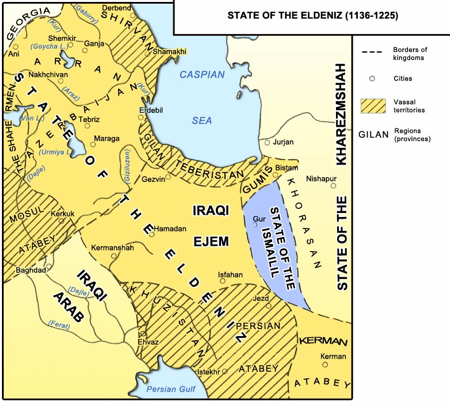 The creation of the Great Saljuk Empire by Sultan Toghrul (1038-1063) marked the beginning of vast changes in world history. Azerbaijani lands, including Nakhchivan were annexed to the Great Saljuk Turkish Empire. The ancient Turkish land of Nakhchivan progressed further in this period.
The creation of the Great Saljuk Empire by Sultan Toghrul (1038-1063) marked the beginning of vast changes in world history. Azerbaijani lands, including Nakhchivan were annexed to the Great Saljuk Turkish Empire. The ancient Turkish land of Nakhchivan progressed further in this period.Following the collapse of the Great Saljuk Empire, the Azerbaijan Atabeys - Eldanizs State [1136-1225] was created in the territory of Azerbaijan by Shamsaddin Eldaniz [1136-1175]. Nakhchivan became the capital of the Atabeys State. The treasury of the Atabeys State was kept in the Alinje Castle near the city of Nakhchivan. During the reign of the Azerbaijani governor Mahammad Jahan Pahlavan (1175-1186), Nakhchivan was ruled by Qizil Arslan and after his death, his wife Zahide khatun. In the period of the Atabeys-Eldanizs, Nakhchivan gained world fame as one of the economic, political and cultural centers of Azerbaijan. A very valuable source referring to Nakhchivan reports: «Nakhchivan is a densely populated big city in Azerbaijan, which was built on a high place and greatly strengthened. Many palaces, pavilions and porches have been built (there) a stone castle has been erected near the city with madrasahs and mosques constructed inside.
There is a good spring in the castle. They say, there is no other city in the world better organized than this one; raw and baked bricks have been used in the construction of all the buildings. Most of the pavilions are three-or four-layered like towers. The city’s surrounding area has all the amenities with running water, gardens and lawns. The Araz River flows through the city. Nakhchivan reached its full magnificence during the reign of His Excellency Eldaniz. The Darul-mulk (Shah’s Residence) and Dovlatkhana (the central government building) were built there».
With its peculiar features, Nakhchivan architecture became an individual school in the period of the Atabeys. The Nakhchivan architectural school was founded by the great artisan and profound thinker Ajami Abubakr oghlu Nakhchivani and became famous throughout the Orient.
Kharazmshah Jalaladdin eliminated the Atabeys-Eldanizs State, which had weakened due to Mongol attack in 1221. Nakhchivan was occupied by Kharazmshah, which lasted until 1231. The second Mongol attack [1231-1239] restored the Mongolian reign in Azerbaijan.
When the fifth Mongolian ulus Hulakus (or Elkhanis) was established in 1256, Azerbaijani lands were included in this state. At that time, Nakhchivan was one of the nine administrative tumens (districts) of the southern lands of Azerbaijan. Five out of the 27 Azerbaijani cities - Nakhchivan, Alinje, Ordubad, Azad and Maku were included in the Nakhchivan tumen. During this period, the Gold Army (Red Orda), the Chobanis and the Jelairis were struggling for dominance over Azerbaijan. The strengthening of Amir Teymur's (Tamerlan the Great) [1370-1405] power aggravated the situation even more. Amir Teymur occupied the territories of Nakhchivan in 1387. The Alinje Castle was besieged. The defenders of the Alinje Castle struggled fearlessly against Teymur’s troops for 14 years and did not surrender the castle. The Hurufis played an essential role in the fight against the Teymuris. The founder of Hurufism, the great Azerbaijani philosopher
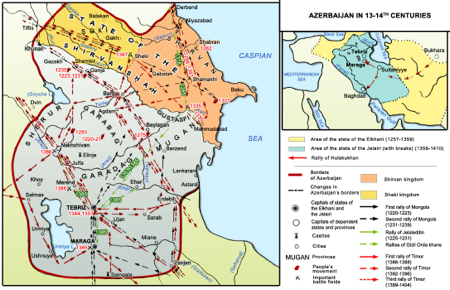 Fazlullah Naimi, was killed by Teymur’s son, Miranshah, in 1394 in Nakhchivan. (At present, Naimi’s tomb has become a sacred pilgrimage place for people). After 14 years of heroic struggle, the Alinje Castle fell owing to internal disputes. Some time after this event, Teymur came from Tabriz to Nakhchivan, rose to the top of the Alinje Castle, and was fascinated by its might.
Fazlullah Naimi, was killed by Teymur’s son, Miranshah, in 1394 in Nakhchivan. (At present, Naimi’s tomb has become a sacred pilgrimage place for people). After 14 years of heroic struggle, the Alinje Castle fell owing to internal disputes. Some time after this event, Teymur came from Tabriz to Nakhchivan, rose to the top of the Alinje Castle, and was fascinated by its might. Notwithstanding the complexity of the historical circumstances in the XIII-XIV centuries, Nakhchivan was developing culturally and socioeconomiqally. Considerable progress was observed in the fields of agriculture, craftsmanship and trade. During this period, the cities of Nakhchivan, Ordubad and Julfa held a remarkable place in the urban life of Azerbaijan. Distinguished figures of state, science and culture lived and worked in Nakhchivan.
Born in Nakhchivan, the famous Azerbaijani intellectual Nasiraddin Tusi was a brilliant Azerbaijani scholar and holds a worthy place among the scientific greats of the world.
Sanjar ibn Abdullah an-Nakhchivan’s son, Hindushah Nakhchivani (1245-1328), his grandson Mahammad ibn Hindushah Nakhchivani (1295-1376) and his great-grandson Kamaladdin ibn Mahammad Nakhchivani hold an honorable place in the scientific history of Azerbaijan. Hindushah Nakhchivani was a distinguished historian, linguist, philosopher, scholar and state figure with a deep and comprehensive encyclopedic knowledge. His son Mahammad also followed his path. Mahammad ibn Hindushah Nakhchivani’s two most valuable works have reached our times.
Sanjar ibn Abdullah’s other son Seyfaddovle Nakhchivani held high state positions during the reign of the Elkhanis, and played a vital role in the scientific development of his brother Hindushah.
The well-known philosopher Najmaddin Nakhchivani, scholar and thinker Hassan Nakhchivani, physician and Sophist Kamaladdin Nakhchivani, famous advocate Gavamaddin Nakhchivani and others have also left deep traces in the scientific and cultural history of Azerbaijan.
In the XIII-XIV centuries, the Nakhchivan architectural school successfully continued its previous traditions. Ahmad ibn Eyyub al-Hafiz Nakhchivani, the architect Jamaladdin Nakhchivani and others had significant accomplishments in this field. Ahmad ibn Eyyub al-Hafiz Nakhchivani is the architect of the Bar da Sepulcher (1322) and the Garabaghlar Sepulcher (30s of the XIV c.), and Jamaladdin is the architect of the Khanegah Sepulcher.
These reliable sources provide valuable information about the history of Nakhchivan in the XIII-XIV centuries. Very important archeological materials have been discovered belonging to this period. The Alinje (Julfa district) and Babi (Shahbuz district) mints, Nakhchivan Jumeh Mosque, Kharabagilan, the Vanand Mosque, the Nusnus Pir (sacred place - trans.), Bilav Necropolis, Dar Sepulcher, Duylun Pir (Ordubad district), Ziyaulmulk Bridge, Gulustan Sepulcher (Julfa district), the Old Castle (Shahbuz district), Dadali Bridge (Sharur district), the Garabaghlar Sepulcher (Kangarli district), the Aghoghlan Sepulcher (Sadarak district) and other monuments speak of the rich history of this period.
In the XV-XVI centuries, Nakhchivan was a part of the Azerbaijani Garagoyunlu, Aghgoyunlu and Safavid states. Nakhchivan was one of the most important districts of the Safavid state.
Possessing a vital military-strategic position, Nakhchivan became the hottest point of the Safavid-Ottoman wars starting from the beginning of the XVI century, and passed from one dominion to the other scores of times. During the reign of Mahammad Khudabende [1578-1587], control over Nakhchivan was charged to the heads of the Kangarli-Ustajli tribe, which was one of the most militant tribes in Azerbaijan. The Kangarlis, having settled in the territory of Nakhchivan together with the Pechenegs as far back as early AD, took an active part inside the Ustajli tribe in the creation of the Safavid state. The heads of the Kangarli tribe were the hereditary governors of Nakhchivan until the Russian invasions at the beginning of the XIX century.
Azerbaijan, including Nakhchivan, again faced heavy tests from history from the late XVI century until the 40’s of the XVIII century. The country became a field of military-political rivalry among the Safavid, Ottoman and Russian empires. The bloody skirmishes once again struck a hard blow to Nakhchivan’s development. Finally, the Safavid ruler Shah Abbas the First succeeded in recovering Nakhchivan and the other Azerbaijani lands.
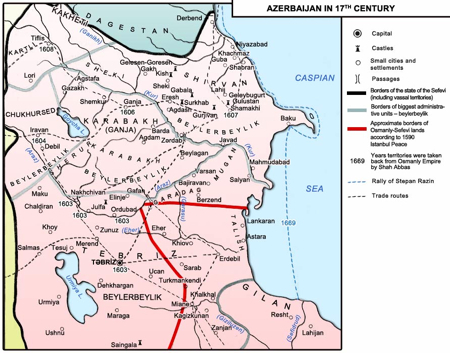 Appointed the vizier during the reign of Shah Abbas the First, Hatambey Ordubadi played an important role in the running of the great Safavid Empire. After his visit to Ordubad in 1606, Shah Abbas the First presented the city to him as soyurgal and Hatambey realized extensive construction works there. The population of Ordubad was exempted from taxes by a decree of Shah Abbas the First (1607). The inscription of the decree still remains.
Appointed the vizier during the reign of Shah Abbas the First, Hatambey Ordubadi played an important role in the running of the great Safavid Empire. After his visit to Ordubad in 1606, Shah Abbas the First presented the city to him as soyurgal and Hatambey realized extensive construction works there. The population of Ordubad was exempted from taxes by a decree of Shah Abbas the First (1607). The inscription of the decree still remains. The protracted Safavid-Ottoman wars ended in 1639. Nakhchivan remained a part of the Safavid state until the beginning of the XVIII century.
At the beginning of the XVIII century, several parts of Azerbaijan, including Nakhchivan, passed into the dominion of the Ottoman Empire. While being a part of the Ottoman Empire, in 1727, a census document titled «The detailed notebook of the Nakhchivan Sanjag» was compiled.
This valuable historic document is also a very important source for studying the history of Nakhchivan. It provides reliable information about the administrative-territorial divisions of Nakhchivan, the amount of taxes paid, the number of people, etc.
ANNUAL INCOME OF THE NAKHCHIVAN SANJAG
№ |
Districts |
Annual income (in akhcha) |
Number of settlements |
Special weight in the sanjag’s annual income |
Number of taxpayers and the percentage of population of sanjag |
1 |
Nakhchivan |
323.229 |
12 |
12,3 |
777 (7,9) |
2 |
Alinje |
243.164 |
28 |
9,3 |
1.450(14,8) |
3 |
Sair Mavazi |
152.342 |
16 |
5,8 |
151(1,5) |
4 |
Darashahbuz |
104.398 |
21 |
3,9 |
153(1,6) |
5 |
Mulki-Arslan |
89.333 |
8 |
3,4 |
550 (5,6) |
6 |
Mavaziyi-Khatun |
44.431 |
9 |
1,7 |
42 (0,4) |
7 |
Garabagh |
293.430 |
15 |
11,2 |
247 (2,5) |
8 |
Gishlaghat |
261.371 |
11 |
9,9 |
2.436 (24,9) |
9 |
Darasham |
47.865 |
4 |
1,8 |
264 (2,7) |
10 |
Azadjiran |
408.455 |
37 |
15,5 |
2.918(29,9) |
11 |
Shorlut |
28.870 |
5 |
1,1 |
133(1,4) |
12 |
Daranurgut |
18.409 |
5 |
0,7 |
56 (0,6) |
13 |
Sisyan |
192.916 |
42 |
7,3 |
189(1,9) |
14 |
Daralayaz |
420.846 |
102 |
16,0 |
422 (4,3) |
The table shows that every year the 9,788 taxpayers of the Nakhchivan sanjag would pay 2,629069 akhchas (axca) to the treasury.
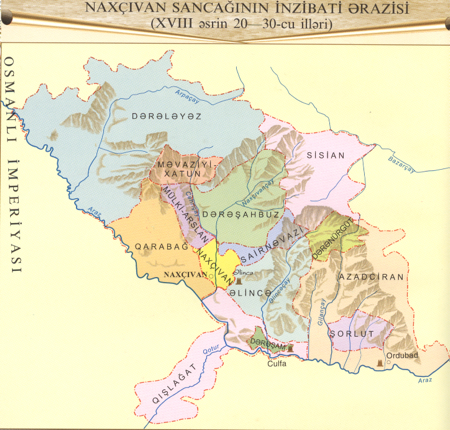 Lots of numismatic materials, stone ram statues, the Imamzadeh Complex (sanctuary where descendants of imams are buried - trans.), the Zaviye Mosque (the city of Nakhchivan), the Jumeh Mosque, the Amaras Mosque, the Behrud Bridge (Ordubad district), the Arazin Necropolis (Julfa district), the Parchi Imamzadeh (Sharur district), the Koroghlu Castle (Sadarak district) and other valuable examples of cultural and historical monuments belonging to the history of Nakhchivan from the XV untill the early XVIII centuries have been left to today’s generations.
Lots of numismatic materials, stone ram statues, the Imamzadeh Complex (sanctuary where descendants of imams are buried - trans.), the Zaviye Mosque (the city of Nakhchivan), the Jumeh Mosque, the Amaras Mosque, the Behrud Bridge (Ordubad district), the Arazin Necropolis (Julfa district), the Parchi Imamzadeh (Sharur district), the Koroghlu Castle (Sadarak district) and other valuable examples of cultural and historical monuments belonging to the history of Nakhchivan from the XV untill the early XVIII centuries have been left to today’s generations.
After the great Azerbaijani warlord Nadir came to power [1736 - 1747], the Azerbaijani lands under Ottoman domination were returned and added to the Afshar Empire. Trying to strengthen his power in Nakhchivan, which was of vital strategic importance, Nadir Shah Afshar exiled the renowned representatives of the brave Kangarli tribe from the country. However, Nadir’s power did not last long in Nakhchivan, as well as in the rest of Azerbaijan. After Nadir was killed (1747), small local states - khanates were established in Azerbaijan.
The Period of Khanates
After Nadir was killed (1747), small local states - khanates were established in Azerbaijan.
Following Nadir’s death, the head of the Kangarli tribe, Heydavgulu Khan [1747 - 1764] declared the creation of the Nakhchivan khanate. Nevertheless, the intervention of neighboring states as well as palace intrigue caused the weakening of the Nakhchivan khanate. A certain stability came to the khanate only during the reign of Kalhali Khan [1787-1820].
In 1795, Agha Mahammad Shah Gajar attacked Azerbaijan. The Nakhchivan khanate also suffered attacks. In turn, Kalbali Khan was inclined towards building a relationship with the commander of the Russian army, V.Zubov, who was about to invade Azerbaijan.
During his next attack in 1797, Agha Mahammad Shah Gajar punished the khan of Nakhchivan. Kalbali Khan’s eyes were blinded, and a part of the Kangarli tribe was again exiled from Nakhchivan. Abbasgulu Khan was brought to the throne. The assassination of Gajar in Shusha in 1797 changed the political situation. The danger of the occupation of Azerbaijani lands by Russia increased further.
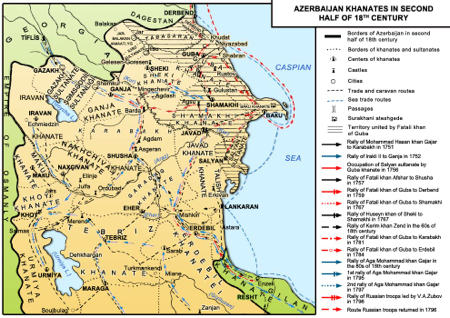 The Russian Empire started a war against Azerbaijan in 1803. Longing to regain Azerbaijan, Iran, ruled by the descendants of Gajar, also launched a war against Russia in 1804. The Russian-Iranian war [1804-1813] ended on October 12, 1813 with the Gulustan Treaty. In accordance with this Treaty, the lands of Azerbaijan were divided for the first time between Russia and Iran. The northern Azerbaijani lands were annexed to the Russian Empire, while the Nakhchivan and Iravan khanates together with the southern khanates of Azerbaijan fell under the domination of the Gajars Iran.
The Russian Empire started a war against Azerbaijan in 1803. Longing to regain Azerbaijan, Iran, ruled by the descendants of Gajar, also launched a war against Russia in 1804. The Russian-Iranian war [1804-1813] ended on October 12, 1813 with the Gulustan Treaty. In accordance with this Treaty, the lands of Azerbaijan were divided for the first time between Russia and Iran. The northern Azerbaijani lands were annexed to the Russian Empire, while the Nakhchivan and Iravan khanates together with the southern khanates of Azerbaijan fell under the domination of the Gajars Iran.
Soon the Gajars again tried to regain the Azerbaijani lands occupied by Russia, while the latter wanted to end their invasion of Azerbaijan. This caused a new war between these empires which lasted from 1826 until 1828. On June 26, 1827 Russian troops entered Nakhchivan. On October 1, the Iravan Castle was occupied. Russian military forces then launched expansionist operations into the southern lands of Azerbaijan. The lands of Azerbaijan were divided a second time between Russia and Iran under the Turkmanchay Treaty concluded between Russia and the Gajars state on February 10, 1828. In ac cordance with the Turkmanchay Treaty, 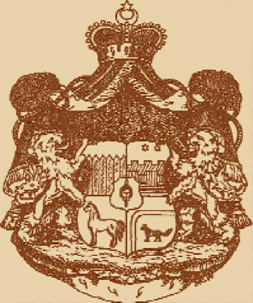 the Nakhchivan and Iravan khanates were also annexed to Russia.
the Nakhchivan and Iravan khanates were also annexed to Russia.
In 1747-1797, the Nakhchivan khanate was divided into separate administrative-territorial mahals. In 1797-1828, the khanate consisted of the Nakhchivan and the Ordubad administrative mahals. The Nakhchivan okrug included the Alinje, Khok and Daralayaz mahals, and the Ordubad okrug included the Ordubad, Aylis, Deste, Channab and Bilav mahals. There were two cities, Nakhchivan and Ordubad, in the khanate’s territory.
The traditional local occupations - agriculture and craftsmanship - held a predominant place in the economic life of the Nakhchivan khanate. The treasury (belonging to the state), khalise (belonging to the khan’s family), mulk (patrimony), vaqf (belonging to religious people - trans.) and jamaat lands (belonging to the village community) were the main forms of land ownership.
In addition to several numismatic materials, the Jumeh Mosque, the Khan's House, Ehsan Khan’s Palace, the Ismayilkhan Baths (the city of Nakhchivan), the Sershahar, Dilbar and Dirnis mosques, the Darkand bridge (Ordubad district), the Imamzadeh of Nehram (Babak district), the Sadarak Mosque and other historical monuments have been left as mementos of the period of the Nakhchivan’s khanate.
Khans of Nakhchivan
Heydargulu khan Kangarli (1747-1764)Haji khan Kangarli (1764-1765)
Rahim khan Kangarli (1765-1770)
Aligulu khan Kangarli (1770-1773)
Valigulu khan Kangarli (1773-1781)
Abbasgulu khan Kangarli (1781-1783, 1797-1801, 1806)
Jafargulu khan Kangarli (1783-1785)
Karim khan (1808, 1813-1816, 1823-1827)
Kalbali khan Kangarli (1787-1796, 1801-1807, 1809-1810, 1816-1820)
Huseyn Mirza – judge (1822-1823)
Mahammad Baghir khan (1827)
Ehsan khan Nakhchivanski – judge (1828-1839)
The Period of Occupation by Russia
The period starting from the Russian invasion and lasting until the 1917 October Revolution marks the most difficult period of Nakhchivan’s history. Russia succeeded in establishing an intolerable colonial regime in Nakhchivan, as well as the rest of Azerbaijan. 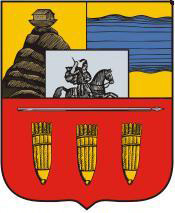 The historically formed local and traditional administrative-territorial divisions of Nakhchivan were purposefully changed. The massive movement of Armenians from Iran commenced with the aim of settling them in the ancient Azerbaijani lands, including the territory of the former Nakhchivan khanate. The land of Nakhchivan became a provider of raw materials for Russian industry.
The historically formed local and traditional administrative-territorial divisions of Nakhchivan were purposefully changed. The massive movement of Armenians from Iran commenced with the aim of settling them in the ancient Azerbaijani lands, including the territory of the former Nakhchivan khanate. The land of Nakhchivan became a provider of raw materials for Russian industry.
After the Azerbaijani states of Nakhchivan and of Iravan were annexed to Russia in 1828, the tsarist regime inflicted the cruelest act of hostility against the Azerbaijani people: on March 21, 1828, the Novruz Holiday day, the «Armenian District» was created on the lands of both Azerbaijani khanates. The Armenians relocated from Iran and Ottoman territories were settled in these original Azerbaijani lands.
The resettlement of Armenians on the Azerbaijani lands was accompanied by the strong resistance of the local Azerbaijani population.
By resettling Armenians into Azerbaijan, Tsarist Russia laid the foundation for today’s Armenian state in the Southern Caucasus on the lands of Azerbaijan.
During the period until 1874, Nakhchivani territories were repeatedly subjected to administrative territorial division and a large portion of the former lands of the khanate was included in Nakhchivan gaza. 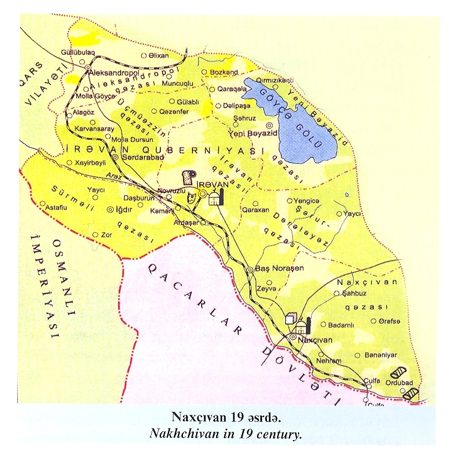 At the same time, the policy of purposeful Armenianization of Nakhchivani territory was implemented. Armenians from Iran and Turkey were moved into the ancient lands of Azerbaijan, including Nakhchivan, which was leading to an intentional change of the population’s ethnic composition. However, the Turkish- Moslem population of Nakhchivan was determinedly struggling against this ruthless policy, not letting the Armenians strengthen their position on the native motherland of Azerbaijanis.
At the same time, the policy of purposeful Armenianization of Nakhchivani territory was implemented. Armenians from Iran and Turkey were moved into the ancient lands of Azerbaijan, including Nakhchivan, which was leading to an intentional change of the population’s ethnic composition. However, the Turkish- Moslem population of Nakhchivan was determinedly struggling against this ruthless policy, not letting the Armenians strengthen their position on the native motherland of Azerbaijanis.
According to archival data, due to the resettlement policy of the Russian Empire the population’s ethnic composition in the different mahals of the Nakhchivan administrative okrug in 1830 was as follows:
DIVISON OF POPULATION, INCLUDING THE RESSETLED ARMENIANS, IN THE MAHALS OF THE NAKHCHIVAN OKRUG (1830-ties)
Mahals |
Number of villages |
Economies |
||
Azerbaijanis |
Armenians |
|||
Resettled before 1830 |
Resettled after 1830 |
|||
Alinje |
24 |
400 |
120 |
120 |
Daralayaz |
- |
1283 |
58 |
731 |
Nakhchivan |
59 |
1884 |
309 |
1207 |
Khok |
9 |
292 |
43 |
|
The city of |
- |
905 |
156 |
269 |
As evident from the table, despite the massive resettlement of Armenians, the majority of the population of Nakhchivan consisted of Azerbaijanis. Information about Ordubad okrug and Sharur also confirm that, the plan of changing the ethnic composition in Nakhchivan’s population in the favor of the Armenians had not succeeded.
On the eve of the October Revolution in 1917, the population of Nakhchivan totaled 170.142. Of them, 122.208 lived in Nakhchivan gaza, 40.000, in Sharur, and 8.934 in the city of Nakhchivan.
The economy of Nakhchivan was also adjusted to the requirements of Tsarist colonial policy. Nakhchivan’s industry consisted of salt mines and several weaving manufacturers. The cotton-growing and sericulture fields were also developed.
The people of Nakhchivan were resolutely fighting against injustice and national oppression. Extensive peasant revolts broke out here during the 1905-1907 revolutionary period. The population of Nakhchivan suffered from massive massacres and violence during the 1905-1906 genocide committed against the Azerbaijanis by the Armenians, and struggled heroically against the Armenian bandits and their tsarist supporters. This bloody tragedy of Nakhchivan history and the genocide committed by the Armenians against the Azerbaijanis are described with precise facts in the book «Bloody Years» by the great Azerbaijani writer M.S.Ordubadi, who was born in Nakhchivan.
After occupying Nakhchivan, Russia put an end to the inheritable power of the Kangarlis and their proprietary rights over their wide plots of land in Nakhchivan. Despite this, the Kangarlis continued playing an important role in the life of Nakhchivan, as well as in the structure of the Russian Empire’s armed forces. The Kangarli (Nakhchivan) Squad Detachment (1829) and the Nakhchivan Bey Public Order Squad (1853) operated as part of the Russian armed forces. There were authoritative Nakhchivanis in the officer corps of the Russian army as well. Distinguished historical personalities from Kangarli stock were very famous during that period and even during the early years of Soviet power, when they were known as the Nakhcliivanskiis. The last khans of Nakhchivan, Ehsan Khan’s sons Ismayil Khan (1819-1909) and Kalbali Khan (1824-1883) Nakhchivanskiis and Kalbali khan’s son Hussein khan Nakhchivanskii (1863-1919), Jafargulu khan’s son Jamshid khan Nakhchivanskii (1895-1938), gained great fame in the Russian and Soviet armies for their courage and military organizational talents.
As in previous times, in the XIX and the beginning of XX centuries, Nakhchivan also played an important role in the development and further enrichment of Azerbaijani culture. The earlier traditions of the growth of enlightenment carried on in Nakhchivan; new-method schools, - «Akhtar» and «Terbiye», opened in Ordubad and Nakhchivan in 1882 and 1894 respectively. M.T.Sidgi, who played a special role in the opening of these schools, also established the first secular girls’ school in Nakhchivan in 1896.
Mohammad Agha Shahtakhtli (1846-1931), Mahammad Taghi Sidgi (1854-1903), Jalil Mammadguluzadeh (1869-1932), Mammad Said Ordubadi (1872-1950), Aligulu Gamkusar (1880-1919), Hussein Javid (1882-1941), Bahruz Kangarli (1892-1922), Aziz Sharif (1895-1998), Kazim Ziya (1896-1956), Yusif Mammadaliyev (1905-1961), Islam Safarli (1923-1974), Hussein RaZi(1924-1998), Zarosh Hamzayeva (1925-2004), Mammad Araz (1933-2004), Hussein Ibrahimov (1919), Akram Aylisly (1937) and other figures of science and culture, who were bom in Nakhchivan have had an exceptional influence in the development of science, literature and art in Azerbaijan.
In the XIX century literary assemblies like the «Goncheyi-Ulfet» and «Anjumani-shuara» (Ordubad, 1838) were active in Nakhchivan and the «Assembly (Majlis) of Intelligentsia» and «Moslem Shiah Art and Drama Society» were organized in early 1880’s. The Nakhchivan Theatre was founded in 1883. B.Kangarli (1892-1922) was a pioneer in the development of realist machine dyeing, as well as the genres of portrait and landscape in Azerbaijani art.
During XIX and the beginning of XX century, many fields of folk art, including carpet-weaving, jeweller’s art, weaving and other arts were highly developed.
The Araz Turk Republic
Despite that, on 28 May 1918, the Azerbaijani people restored the independence of their state and created the Azerbaijan People’s Republic. However, the Armenians did not recede from their expansionist plans. The establishment of the Dashnak-Bolshevik government in Baku headed by S.Shaumyan and the withdrawal of Turkish troops from Nakhchivan in accordance with the Mudros truce further aggravated the situation. Taking their chance, the Armenians committed massive massacres against Azerbaijanis, longing to occupy the ancient Azerbaijani lands of Nakhchivan, Zangazur and Garabagh. Surrounded on all sides by enemies, the patriots of independence from Nakhchivan created the Araz Turkish Republic in November 1918 in order to save the people from Armenian genocide. With the city of Nakhchivan as capital, the Araz Turkish Republic covered the Nakhchivan gaza, the Sharur-Daralayaz and Ordubad mahals, as well as Sardarabad, Ulukhanli, Vedibasar, Gamarli, Mehri and other territories. The Republic’s Council of Ministers was headed by Amir bey Akbarzadeh. The Araz Turkish Republic formed armed units to protect the area and population from Armenian attacks and conducted active military operations against the enemy.
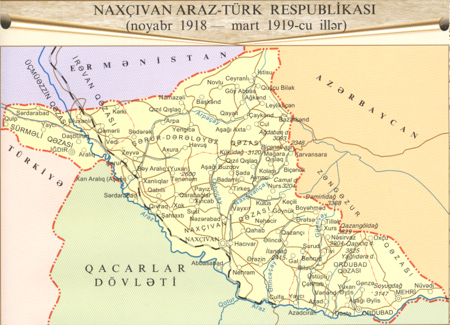 Encircled by enemies, the Araz Turkish Republic considered itself an integral part of the Azerbaijan People’s Republic and used all opportunities to get into contact with Baku. A delegation from the Araz Turkish Republic came from Nakhchivan to Baku on March 8, 1919. The government of the Azerbaijan People’s Republic also tried to pay more attention to Nakhchivan as it was an integral part of Azerbaijan. Yet Nakhchivan was occupied by the English in early 1919. The Araz Turkish Republic collapsed in March 1919 due to the intervention of the English who were supporting the Armenians.
Encircled by enemies, the Araz Turkish Republic considered itself an integral part of the Azerbaijan People’s Republic and used all opportunities to get into contact with Baku. A delegation from the Araz Turkish Republic came from Nakhchivan to Baku on March 8, 1919. The government of the Azerbaijan People’s Republic also tried to pay more attention to Nakhchivan as it was an integral part of Azerbaijan. Yet Nakhchivan was occupied by the English in early 1919. The Araz Turkish Republic collapsed in March 1919 due to the intervention of the English who were supporting the Armenians.
Nevertheless, in this grave time for Azerbaijan, the Araz Turkish Republic played an important role by uniting the area’s Azerbaijani forces against their enemies, prevented the murder of the population by the Dashnaks, and most importantly, did not allow the occupation of the region by the Armenians. Thus, the territorial integrity of the Azerbaijan People’s Republic was ensured.
In the second half of 1919, the USA’s role in the region increased. However, an initiative to establish an American governor general’s office in Nakhchivan failed. Though the government of the Azerbaijan People’s Republic made some progress in the struggle for the country’s territorial integrity in some ways it failed. The republic’s government trusted in an agreement concluded with Armenia on 23 November 1919 and withdrew its troops from Zangazur. Taking advantage of this, Armenians occupied Zangazur. Yet, their invasive plans concerning Nakhchivan did not succeed. Though with grave difficulty, Nakhchivan was protected from the Armenian occupation.
The Genocide Acts by Armenians in Nakhchivan Region
The Azerbaijan nation which has ancient history and culture is one of the nations exposed to the most terrible genocide acts. Armenians were backed by the imperialist powers and became strong in the region after they were moved to the South Caucasus. Thenceforward, starting from the early XX century, they began to procreate genocide against Azerbaijanis from time to time. The massacres exercised in the majority of the regions of Azerbaijan were extended even after the overthrow of tsarism and covered Nakhchivan as well. The Armenians gaining the protection and support of the Soviet Russia thanks to special endeavor of S.Shaumian, band of armed robbers of Andronik in particular, exercised stern barbarism inflicting reprisals towards peaceful Turk-Muslim people of Nakhchivan district in June-August 1918. The people of Yayji (Julfa rayon) were exposed to massacres and the village itself was devastated. The bridge on Araz River in Julfa rayon was burnt and 2000 Turk-Muslim people were wildly massacred. The women, children and the old people were not compassionated, the hot samovars were tied to the back of bare-hand people, the bellies of pregnant women were torn and other inhuman tortures were carried out. Up to 300 innocent people trying to step aside this savagery drowned in Araz River while crossing it.
Another armed Armenian band under the leadership of “Japanese”-named robber drove the people of Almali settlement living on the 40-km north of Nakhchivan city out of their historical homeland. Some 200 men were killed and many young people were captivated. The lives of the people of Nakhchivan were saved from larger-scale slaughters thanks to the Ottoman armies under the leadership of Kazim Karabekir coming to the region.
In early 1919, the armed forces under the leadership of Armenian colonel Dolukhanov used violent force against the peaceful people greeting them in Sharur-Sadarak regions. The siege was laid to 8 Muslim villages, Damirchi village were plundered, 60 people being jailed were sent to Iravan, and 200 people drowned in Araz River while crossing it. The Armenian military unit encountered with the stiff resistance of local people was obliged to step back.
In the first half of 1919, also during the English and Armenian governorship in Nakhchivan district inadmissible violence acts were imposed to the Azerbaijani people of the district. During the two-month “Armenian governorship” (May-July, 1919) up to 330 investigations were conducted, about 600 guiltless residents were jailed, and horrible tortures were imposed to approximately 150 people. The successful one-week (19-25 July) rebellion of local people of the region against the “Armenian governorship” entailing the withdrawal of dashnak armed forces from the district barred new genocide acts.
As result of the ethnic cleansing policy, namely “burnt soil”, conducted by Armenians, refugees turned out to be challenging problem for Nakhchivan in 1918-1920. Turk-Muslim people driven out by Armenians from the outskirts of Iravan and the Zangazur immigrated to 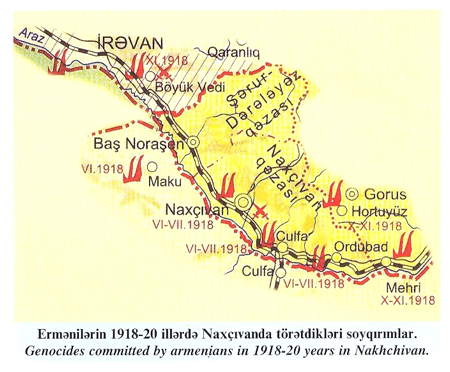 Nakhchivan on the one hand, and many residents of the region migrated to the South Azerbaijan during Andronik’s occupation and the “Armenian governorship”, on the other. The attacks of Armenian military units to Ordubad district in March 1920 entailed the massacre of many innocent people.
Nakhchivan on the one hand, and many residents of the region migrated to the South Azerbaijan during Andronik’s occupation and the “Armenian governorship”, on the other. The attacks of Armenian military units to Ordubad district in March 1920 entailed the massacre of many innocent people.
The Turk-Muslim population of Nakhchivan was also subject to genocide after the occupation of North Azerbaijan by Russia, during the initial period of Soviet authority. One of these horrible slaughters happened during summer months of 1920. The official research-investigations as to savagery and violence acts against the peaceful people of Zangabasar-Vedibasar-Shahtakhtı-Sharur by the Armenian armed forces during the bloody march entailed the facts as follows:
In Zangabasar, 48 villages were completely burnt, 18 girl and young women were captivated, more than 400 children and 150 old people were killed, 100 sick people were burnt, 816 refugees drowned in Araz, and 160 thousand people became homeless in South Azerbaijan after migration. In Vedibasar, 118 villages were burnt, 900 people were killed by gun-firing, 6 women were captivated and more than 300 children and old people were executed. Furthermore, 74 villages in Daralayaz and 76 villages in Sharur and Shahtakhti were burnt. In Sharur, 810 people were executed in sick bed, 144 women were captivated, 72 people were killed by gun-firing, and 150 old people and women were killed. In Shahtakhti, moreover, 3 women were put into captivity, 35 children, 14 old men, 8 women and 9 sick people were killed.
In total, 73.727 Turk-Muslim people were wildly killed in Nakhchivan region by the Armenian robber bands in 1918-21. 50 thousand neat and small cattle were taken from these districts, and 500 thousand people were made extremely poor. More than 45 thousand people moving to the South Azerbaijan because of massacre and plunder perished after starvation and disease. 70 thousand of refugees in South Azerbaijan and 400 thousand of refugees in Nakhchivan became homeless.
The Azerbaijan People’s Republic collapsed as a consequence of the April invasion of 1920. Northern Azerbaijan was sovietized. On July 28, 1920 Soviet power was established in Nakhchivan and the Nakhchivan Soviet Socialist Republic was created. The Republic’s supreme authority was the Military Revolutionary Committee (MRC). M.Baktashov, A.Gadimov, F.Mahmudbeyov, G.Babayev and others were included in the MRC. A letter of the MRC dated 10 August 1920 addressed to Nariman Narimanov, the chairman of the Azerbaijan SSR People’s Council of Commissars, reported that taking into consideration the will and requirements of the overwhelming majority of the working class, the land of Nakhchivan had announced itself an integral part of the Azerbaijan SSR.
Yet, in order to realize this important decision, Nakhchivan needed to be protected from Dashnak-Armenian aggression. In September 1920, the attack of Dashnak-Armenian military units into Nakhchivan commenced. Nevertheless, the people of Nakhchivan united to defend their native land and repelled the attack. Ordubad was liberated on September 18. A new attack by Armenian military units in November was also repulsed. Sharur was liberated in a counterattack. Thus, at that time also the population of Nakhchivan did not let their native land be conquered by Armenians.
After the XI Red Army formed Soviet power in Armenia on 29 November 1920, the danger for Nakhchivan further increased. Soviet Russia tried to annex Nakhchivan to Armenia through different ways. Only the resolute resistance and struggle of the Nakh- chivani population prevented the realization of this anti-Azerbaijan policy. The Azerbaijan SSR Commissar of Justice Behbud agha Shahtakhtinski (1881-1924) played an essential role in this process. Due to these factors, the Armenian Military Revolutionary Committee recognized Nakhchivan as an independent soviet republic and declared to the world that the Dashnaks ended their claims concerning this territory.
This declaration of the Armenian Military Revolutionary Committee was simultaneously consistent with the foreign policy of Soviet Russia regarding the region, which was trying to get close with Kamalist Turkey.
Therefore, it was necessary to take real steps and make use of their success and provide autonomy for Nakhchivan within the Azerbaijan SSR. This needed firstly an agreement between Ankara and Moscow quaranteing the autonomy of Nakhchivan within the Azerbaijan SSR. In February-March 1921, negotiations were conducted with this aim. B.Shahtakhtinski, who had left for Moscow at that time on N.Narimanov’s instruction, played an exceptional role in the negotiations.
As a result of Soviet-Turkish negotiations, the Moscow Agreement was signed between the two countries on 16 March 1921. The agreement consisted of 16 articles and 2 annexes. Article 3 reads as follows: «Both of the contracting parties agree that the Nakhchivan district creates an autonomous territory under the protectorate of Azerbaijan within the boundaries indicated in Annex I (s) of the present Agreement on the condition that Azerbaijan must not concede this protectorate to a third state». This article was of historic significance in the determination of Nakhchivan’s destiny. The Soviet-Turkish agreement concluded in Gars (Kars) in 13 October 1921, also confirmed this article. The agreement’s fifth article stated that the Turkish government and the governments of Soviet Armenia and Azerbaijan agree that the Nakhchivan district be established as an autonomous territory under the patronage of Azerbaijan within the boundaries indicated in Article 3 of the present Agreement. The Azerbaijan Central Executive Committee’s (CEC’s) session dated March 3, 1922 ratified the agreements concluded on March 16 and October 13, 1921. This marked the launch of the legal implementation of the agreements’ articles regarding Nakhchivan. The Azerbaijan SSR was fulfilling its tasks arising from its legitimate rights regarding the Nakhchivan SSR. Yet, the legal confirmation of Nakhchivan’s rights as an autonomous republic within the Azerbaijan SSR was delayed until February 1924.
Nakhichivan Autonomous Region
In December 1922, the Azerbaijan SSR, the Georgian SSR and the Armenian SSR united within the Transcaucasian Soviet Federative Socialistic Republics (TSFSR). On December 30, the three republics entered into the USSR within the TSFSR. This limited the sovereign rights of the Azerbaijan SSR. Yet, the registration of the autonomy of Nakhchivan within the Azerbaijan SSR though delayed was realized. On 27 February 1923, the III All-Nakhchivan Congress of Soviets adopted the decision on the inclusion of the Nakhchivan SSR into the Azerbaijan SSR based on the rights of autonomy and addressed to the Azerbaijan CEC. The third session of the Azerbaijan CEC confirmed the decision of the All-Nakhchivan Congress of Soviets.
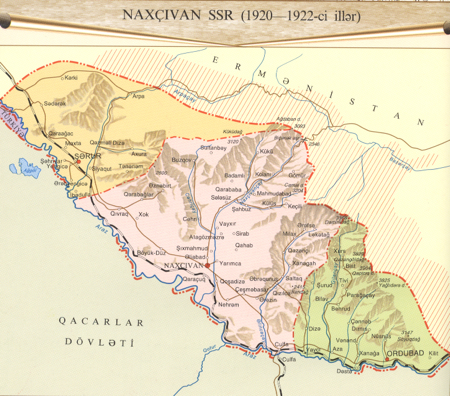 The organization of the Nakhchivan SSR as an autonomous land was realized based on the Regulations of the Azerbaijan CEC on the Nakhchivan Autonomous District. Thus, the previous political rights of Nakhchivan were restricted. This could not be considered satisfactory for Nakhchivan, which was living isolated from the republic. Therefore, the issue of turning the Nakhchivan Autonomous District into an Autonomous Republic was put forward in late 1923. The Azerbaijan CEC adopted a decision on this issue on December 31, 1923. The first plenum of the Transcaucasian CEC held on January 8, 1924 adopted a decision on turning the Nakhchivan Autonomous District into an Autonomous Republic. The above mentioned decision of the higher authorities was confirmed, and the Nakhchivan ASSR governmental authorities were established.
The organization of the Nakhchivan SSR as an autonomous land was realized based on the Regulations of the Azerbaijan CEC on the Nakhchivan Autonomous District. Thus, the previous political rights of Nakhchivan were restricted. This could not be considered satisfactory for Nakhchivan, which was living isolated from the republic. Therefore, the issue of turning the Nakhchivan Autonomous District into an Autonomous Republic was put forward in late 1923. The Azerbaijan CEC adopted a decision on this issue on December 31, 1923. The first plenum of the Transcaucasian CEC held on January 8, 1924 adopted a decision on turning the Nakhchivan Autonomous District into an Autonomous Republic. The above mentioned decision of the higher authorities was confirmed, and the Nakhchivan ASSR governmental authorities were established.
The decree dated February 9, 1924 of the Azerbaijan CEC adopted the transformation of the Nakhchivan Autonomous District into the Nakhchivan Autonomous Soviet Socialistic Republic. Thus, the hostile activities of Armenians aimed at cutting off Nakhchivan from Azerbaijan failed, and the fact that Nakhchivan is an integral part of Azerbaijan with a place in the Azerbaijani state was placed on a fair legal foundation.
The Nakhchivan Autonomous Republic
The history of the Nakhchivan Autonomous Republic is divided into two periods:
1. The Soviet Period [1924-1991];
2. The Independence Period [from 1991 up to the present].
At the time of establishment, the territory of the Nakhchivan Autonomous Republic covered only 5.988 sq. km of its historic territories. In 1929-1930 and after the Kremlin supported the new territorial claims of Armenians in contradiction to the provisions of the 1921 Moscow and Gars (Kars) Agreements. As a result, the territory of the Nakhchivan Autonomous Republic was reduced further. Presently, the Nakhchivan Autonomous Republic covers an area of 5.365 sq. km. This makes up 6.2% of the total territory of the Republic of Azerbaijan. The distinguished leader of the Azerbaijani people, Heydar Aliyev, said at the meeting of the Republic of Azerbaijan Constitutional Commission held on January 14, 1998: «The Autonomy of Nakhchivan is a historic achievement, we should maintain this. The autonomy of Nakhchivan is a very major factor serving for the restoration of its other lost lands. We have to protect and maintain this factor».
In the Soviet period, the vital statistics of the Nakhchivan ASSR population changed as follows:
VITAL STATISTICS OF THE NAKHCHIVAN ASSR POPULATION BASED ON
THE ALL-UNION CENSUSES
(1926-1989; thousand people)
Years |
In the Azerbaijan SSR |
In the Nakhchivan ASSR |
||
Total |
Growth |
Population’s % versus the Azerbaijan SSR |
||
1926 |
2.313,7 |
104,9 |
- |
4,53 |
1939 |
3.205,2 |
126,7 |
21,8 |
3,95 |
1959 |
3.697,7 |
141,4 |
14,7 |
3,82 |
1970 |
5.117,1 |
202,2 |
60,8 |
3,95 |
1979 |
6.028,3 |
238,8 |
36,6 |
3,96 |
1989 |
7.037,9 |
295,1 |
59,3 |
4,19 |
Until the war of 1941-1945, the Nakhchivan Autonomous Republic’s population was more than 130.000 people. The war negatively affected the population’s growth rate. The Autonomous Republic’s growth fell from 21,8 thousand in 1939 to 14,7 thousand in 1959. In that year, the portion of the Nakhchivan ASSR population as the total number of the Azerbaijan Republic’s population also reached its lowest extent, totaling 3,82%. In 1970, the population surpassed 200.000. In 1989, the Autonomous Republic’s population was 295.100 with Nakhchivan’s share of the population of the Azerbaijan SSR reaching 4,19%. On the eve of the collapse of the USSR, the population of 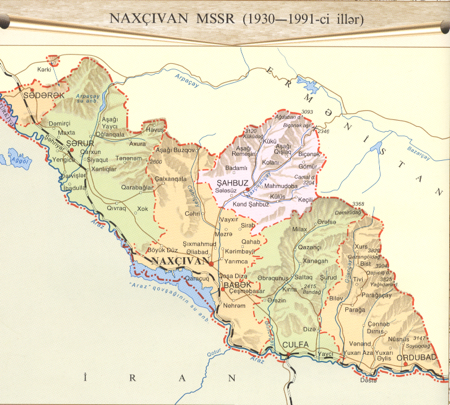 the Nakhchivan ASSR was over 300 000 people. Approximately one third of Nakhchivan’s population lived in the cities, and the rest in villages. During the years of Soviet power, the population of Nakhchivan faced grave political, socioeconomic and cultural problems. Unfortunately, all of these problems have not yet been reflected in the newest historical literature. Heydar Aliyev stated:
the Nakhchivan ASSR was over 300 000 people. Approximately one third of Nakhchivan’s population lived in the cities, and the rest in villages. During the years of Soviet power, the population of Nakhchivan faced grave political, socioeconomic and cultural problems. Unfortunately, all of these problems have not yet been reflected in the newest historical literature. Heydar Aliyev stated:
«... our nation has confronted many tragedies during the XX century. Among them, the evils which happened to Nakhchivan have probably been more tragic and horrible than those which happened to the other regions of Azerbaijan...».
The 1920-1930s have been one of the hardest periods in the history of Nakhchivan. The rule of Nakhchivan in those years was initially set forth by the Regulations adopted by the Azerbaijan CEC in April 1924. The Regulations were in force until the fist Constitution of the Nakhchivan ASSR adopted at the All-Nakhchivan Soviet Congress on April 18, 1926. Later, due to the changes in the USSR and Azerbaijan SSR Constitutions, a new Constitution came into effect in the Nakhchivan ASSR on September 17, 1937.
The repressions of the 1920-1930’s were also very painful in Nakhchivan. Having witnessed those bloody tragedies, Heydar Aliyev would say later on:
«...I am a witness of those days. I was living in Nakhchivan. Within two days, they jammed our weeping neighbors into cars, and then drove them to the other side of the Araz River. I have also seen those exiled from Nakhchivan to Central Asia for political motives in 1937-1938. They were the girls and boys who had studied at high school together with me, coming in tears to bid farewell to us. We did not understand them; when coming to see them off, we would see that in just one day everything in their houses had been thrown about, and they themselves were jammed into cars and driven away».
During the Soviet period, conspiracies against both the population and the territory of Nakhchivan continued. Due to the decision of the Transcaucasian Central Executive Committee Presidium dated 18 February 1929, the Gurdgulag, Khachik, Horadiz villages of the Sharur gaza of Oghbin, Aghkhach, Almali, Itgiran and Sultanbey villages of the Shahbuz province of Nakhchivan gaza, Gorchevan village of the Ordubad gaza, as well as a part of the Kilit village lands, totaling 657 sq. km, were given to Armenia. The territorial conspiracies against Nakhchivan continued as well in 1930: the Armenian Mehri district was created at the cost of the Aldara, Lehvaz, Astazur, Nuvadi and other lands of Azerbaijan.
The Nakhchivan ASSR gave worthy contributions to the victory over fascism during the 1941-1945 war. Najafgulu Rafiyev (1912-1970), Gazanfar Akbarov (1917-1944) and Abbas Gullyev (1916-1998) from Nakhchivan were awarded with the name of Hero of the Soviet Union and thousands of brave men fought with honor against fascism on the fronts of the war. The high-octane gasoline discovered by the great chemist scholar, academician Yusif Mammadaliyev, played a decisive role in the victory of Soviet aviation over the fascist army.
Despite the historic merits of Azerbaijan, as well as Nakhchivan, in the victory over fascism in World War II, no serious changes occurred in the country’s spiritual-political life. The Soviet government continued its unjust policy and discrimination against Azerbaijan. Deportation of Azerbaijanis from the Armenian SSR - their own ancestral lands, was carried out from 1948 to 1953. In 1968-1969, Armenians put in new territorial claims against Azerbaijan. However, the great son of the Azerbaijani people Heydar Aliyev did not allow the realization of these plans of the Armenians.
The years of Heydar Aliyev’s leadership over Azerbaijan during the Soviet period marks a period of advancement of the republic’s, as well as Nakhchivan’s life. In the 1970s - early 1980s, a remarkable revival took place in the socioeconomic, political and cultural life of Nakhchivan. During this period, a new Constitution was adopted in the Nakhchivan ASSR (1978) in accordance with the Constitutions of the USSR and the Azerbaijan SSR.
In the first period of Heydar Aliyev’s leadership over Azerbaijan, the Armenians’ plans of seizing new territories from Azerbaijan, including the Nakhchivan Autonomous Republic, did not succeed. Nevertheless, after Heydar Aliyev left his post in Azerbaijan, in 1985, this disgraced plan came true: a part of the Nakh- chivani lands together with other territories of Azerbaijan were given to the Armenian SSR.
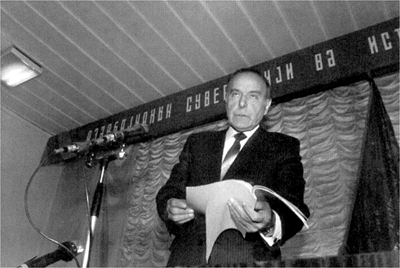 In 1987, Heydar Aliyev was removed from the ranks of the USSR supreme leadership. The then leadership of Azerbaijan failed to seize the political meaning of this step. History did its part. Directly after Heydar Aliyev’s dismissal from power, an aggressive separatist movement sought to remove Daghlig Garabagh from Azerbaijan. Following this, enjoying the all-around support of the USSR leadership, Armenia started an aggressive war against Azerbaijan.
In 1987, Heydar Aliyev was removed from the ranks of the USSR supreme leadership. The then leadership of Azerbaijan failed to seize the political meaning of this step. History did its part. Directly after Heydar Aliyev’s dismissal from power, an aggressive separatist movement sought to remove Daghlig Garabagh from Azerbaijan. Following this, enjoying the all-around support of the USSR leadership, Armenia started an aggressive war against Azerbaijan.
A few hours before the Soviet Army’s atrocities against the peaceful population of Baku at night from January 19 to 20, 1990, Nakhchivan suffered an attack from the Armenian aggressors. Azerbaijan gave its first martyrs in Nakhchivan. Karki village was occupied by the Armenians. An extraordinary decision was adopted in Nakhchivan concerning the autonomous republic’s departure from the USSR. In Moscow, Heydar Aliyev gave the first proper political assessment of the slaughter of January 20, 1990, the next day after the tragedy.
Coming without delay to Baku and not being able to stay in the capital due to the betrayal of the Azerbaijani leadership cringing before the Kremlin, Heydar Aliyev’s return to Nakhchivan saved it from the danger of Armenian occupation during 1990-1993. Realizing his activity in Nakhchivan, Heydar Aliyev was also the beacon of hope for all of Azerbaijan. His speech at the session of the Supreme Soviet in February 1991 and the fact that the referendum concerning the continuance of the USSR should not take place in Nakhchivan are the convincing testimonies of this.
In September 4, 1991, despite his rejection, the Nakhchivan Autonomous Republic’s Supreme Assembly elected Heydar Aliyev its chairman. Soviet power in Nakhchivan was eliminated. A decision was adopted on not holding the presidential elections of the Republic of Azerbaijan in Nakhchivan. The Supreme Assembly’s meeting on September 5 discussed the tense situation in the Autonomous Republic’s economy, as well as the measures for its normalization and relief from the critical situation. The political activeness accompanied with economic conditions was a striking example of Heydar Aliyev’s ideology.
Thus, the two periods of the Nakhchivan Autonomous Republic’s history differing from each other because of their meanings and essence under the leadership of Heydar Aliyev, were parting, the Soviet period was ending and the people’s long-wished period of independence was beginning. The process of building the new Azerbaijan was on in Nakhchivan. This historic process was led by the great leader Heydar Aliyev.
The Period of Independence
Independence is the greatest wish of every nation. Azerbaijan’s achievement of independence once again was a valuable attainment of the people. Unlike Baku, where disputes for power and political anarchy had no limits, Nakhchivan, led by Heydar Aliyev, was at the forefront of the struggle for liberty and the process of building a new life. The decision on the departure from the USSR was initially adopted and the referendum concerning the continuance of the USSR was rejected in Nakhchivan. The process of building a new and independent Azerbaijan was successfully continued in Nakhchivan. Yet, instead of benefiting from Heydar Aliyev’s personality and Nakhchivan’s experience, official Baku continued the path of pressing Nakhchivan and restricting the autonomous republic’s rights. During this period efforts were made for the extraction of the provision of the Republic of Azerbaijan’s Constitution’s Article 112 concerning the chairman of the Nakhchivan Supreme Assembly and for the annulment of Nakhchivan’s autonomy in general. But all these efforts failed. Even in such a complex and historic testing period, the Nakhchivan Autonomous Republic maintained its autonomy due to the wisdom and determination of Heydar Aliyev. This was confirmed later in the Constitution of 1998.
While political anarchy and chaos were raging in Baku because of power clashes, a stable government had formed in Nakhchivan. Achievements in different fields of socioeconomic and cultural life were maintained in Nakhchivan while living under blockade, and a resolute struggle was on for giving it new content. The accomplishments made in Nakhchivan in the period from September 1991 until June 1993 have been reflected in Heydar Aliyev’s speeches, addresses and interviews, as well as documents in the periodic press and different collections. They were dealing mainly with the improvement of the Autonomous Republic’s management system, the preparation and the realization of socioeconomic reforms, the establishment of relations with bordering countries, particularly Turkey, and the new policy for the elimination of the blockade, etc. The opening of the bridge connecting Nakhchivan and Turkey in Sadarak on May 28, 1992 was of particularly great importance. Heydar Aliyev called this bridge «the bridge of our wishes and hopes».
The Nakhchivan Autonomous Republic was becoming a stabilizing factor not only within its boundaries, but also for all of Azerbaijan. This was one of the unmatched virtues of Nakhchivan in the modern history of Azerbaijan. Not accidentally was the attention of the whole republic focused on Nakhchivan during the events of June 1993 when the chairman of the Nakhchivan Supreme Aseembly, Heydar Aliyev, came to Baku by the demand of the people, and changes commenced in the republic’s political leadership. A civil war and the activity of separatist forces were prevented, stability and welfare were restored, and the development and implementation of socioeconomic reforms began. The Salvation Struggle launched by Heydar Aliyev achieved victory. Heydar Aliyev’s care and attention as the head of the Republic of Azerbaijan also played a decisive role in the further development of Nakhchivan.
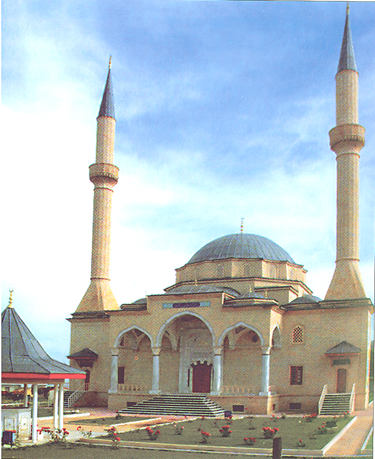 One of the most important political events in the history of the Nakhchivan Autonomous Republic during the period of Azerbaijan’s independence was the adoption of a new Constitution formalizing the achievements it gained in historic and modern development. Chapter VIII of the Constitution (Articles 134-141), which was completed by the committee working on the draft of the new Constitution of the Republic of Azerbaijan under the chairmanship of Heydar Aliyev, and adopted by the referendum of the Republic of Azerbaijan held on November 12, 1995, was completely devoted to the Nakhchivan Autonomous Republic. In January 1998, the draft Constitution of the Nakhchivan Autonomous Republic was discussed at a meeting of the Republic of Azerbaijan Constitutional Committee. The documents linked with the preparation, discussion and adoption of the draft Constitution are extremely important historic sources and their study is of particular significance from the standpoint of the creation of state-building in Azerbaijan, including legislative acts.
One of the most important political events in the history of the Nakhchivan Autonomous Republic during the period of Azerbaijan’s independence was the adoption of a new Constitution formalizing the achievements it gained in historic and modern development. Chapter VIII of the Constitution (Articles 134-141), which was completed by the committee working on the draft of the new Constitution of the Republic of Azerbaijan under the chairmanship of Heydar Aliyev, and adopted by the referendum of the Republic of Azerbaijan held on November 12, 1995, was completely devoted to the Nakhchivan Autonomous Republic. In January 1998, the draft Constitution of the Nakhchivan Autonomous Republic was discussed at a meeting of the Republic of Azerbaijan Constitutional Committee. The documents linked with the preparation, discussion and adoption of the draft Constitution are extremely important historic sources and their study is of particular significance from the standpoint of the creation of state-building in Azerbaijan, including legislative acts.
In his closing speech at the above-mentioned meeting of the Constitutional Committee, Heydar Aliyev said: «Thus, we are both taking a very serious step in the field of Azerbaijani legislation, and regulating these matters. That is, the Nakhchivan Autonomous Republic, having passed through great historic stages, will finally get their appropriate status, a place suiting it within the independent Azerbaijani state, the republic. This is needed for today and for the future».
During the second period of Heydar Aliyev’s leadership over Azerbaijan, immense accomplishments were made as well in the formation and advance of new economic relations, the raising of people’s living conditions, the strengthening of the defence of its borders’, and its cultural development. A majestic sepulcher was erected on the tomb of the distinguished Azerbaijani poet Hussein Javid in accordance with the Nakhchivan architectural school’s traditions on the initiative of Heydar Aliyev (1996).
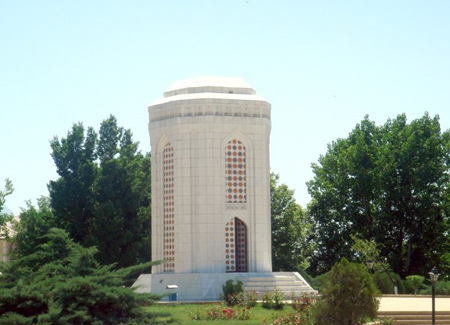 The election of the true follower of Heydar Aliyev’s political line and a distinguished political figure of the contemporary world, Ilham Aliyev, to the presidency of the Republic of Azerbaijan on October 2003 marked a major historic event in the country’s life. Like in June 1993, the Azerbaijani nation again gave their voice: the people trusted their destiny and the fortune of their native Motherland to Heydar Aliyev’s closest companion-in-arms and deserving successor, Ilham Aliyev.
The election of the true follower of Heydar Aliyev’s political line and a distinguished political figure of the contemporary world, Ilham Aliyev, to the presidency of the Republic of Azerbaijan on October 2003 marked a major historic event in the country’s life. Like in June 1993, the Azerbaijani nation again gave their voice: the people trusted their destiny and the fortune of their native Motherland to Heydar Aliyev’s closest companion-in-arms and deserving successor, Ilham Aliyev.
Like in the times of national leader Heydar Aliyev, President Ilham Aliyev also keeps the all-around development of the country, as well as the Nakhchivan AR, in his permanent focus of attention.
The Nakhchivan Autonomous Republic’s role in the expansion of Azerbaijan’s foreign trade relations has also increased. In 2005, the Autonomous Republic’s foreign trade turnover amounted to 53535,6 thousand US dollars.
The socioeconomic life of the Nakhchivan Autonomous Republic has also been rich with memorable events. The international symposium «Nakhchivan: historic realities, modern conditions and development prospects» held by the ANAS A.A.Bakikhanov Institute of History, ANAS Nakhchivan Branch and Nakhchivan State University on June 9-10, 2006 in Nakhchivan was of specific importance. The international symposium, attended by Turkish and Iranian scientists as well, resolutely rejected the ungrounded territorial claims of Armenians concerning Nakhchivan.
Thus, the Nakhchivan AR has shared in the historic life of the Azerbaijan Republic as an integral part and keeps on sharing. As a result of Armenian occupation, the separation of Nakhchivan from Azerbaijan's other territories and the blockade imposed by Armenians on the Autonomous Republic have exposed it to significant challenges. Nevertheless, all of these failed to break the will of Nakhchivan and the Nakhchivanis, making them, in contrast, more steadfast. Exactly the resolute measures taken in Nakhchivan did not allow Armenians to realize their aggressive policy, regarding Garabagh, there also. The brief outline of the ancient and long path of historic development we have reviewed proves once again that Nakhchivan has belonged to Azerbaijan from ancient times as a Turkish land, and is an integral part and one of the most ancient cultural centers of Azerbaijan.
A land of Azerbaijan, Nakhchivan today is a very important district progressing dynamically and integrating successfully into the world community as part of the Republic of Azerbaijan.
Bibliography:
Mahmudov Y, Shukurov K. Nakhchivan: history and monuments. Baku: Təhsil, 2007.Əliyev F., Əliyev M. Naxçıvan xanlığı: 1747-1828. Bakı: Azərnəşr, 1996.
Naxçıvan Ensiklopediyası, I cild, Naxçıvan,2005.
Naxçıvan Ensiklopediyası, II cild, Naxçıvan, 2005.
